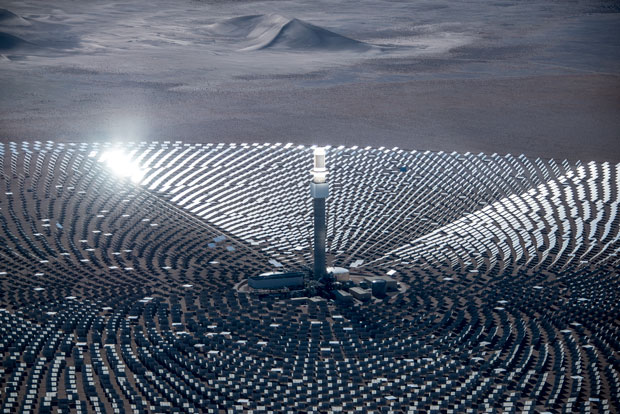One of the loudest criticisms of solar power is that it can’t be accessed after sunset. While this has historically been true, new solar thermal power plants are about to put an end to this argument.
Case in point, the Crescent Dunes solar thermal plant, just outside of Las Vegas, NV has just been completed this October, 2015. Kevin Smith, the plants developer and CEO of SolarReserve has said “When the grid wants 110 MW, we’ll provide 110 MW. There will be no variability.”

The solar thermal plant will be able to do this by heating a mixture of nitrate salts, turning them into a molten state. The heat from the molten salt, stored in insulated tanks, can be accessed for many hours after it has been heated. While other solar thermal power plants must immediately use generated heat to turn steam generators, Crescent Dunes can access the heat for the turbines when it needs.
This molten salt technique also shows promise of being more effective than gas-powered plants. The tower can heat the salt to 566 degrees Celsius, while oil-based plants can only reach 400 degrees Celsius. SolarReserve is working on a ceramic receiver that can hold molten salt that is as hot as 732 degrees Celsius.
To produce a total of 110 Megawatts of power, Crescent Dunes uses over 17,000 mirrors that focuses light on a 165 meter high heat receiver. While smaller than the nearby Ivanpah tower, the major difference here is the aforementioned ability to store energy.
While natural gas may currently be relatively cheap in the United States compared to many parts of the world, it will only be a matter of time before solar will beat gas-fired plants on cost. In fact, it’s beginning to happen. Of course, gas-fired plants represent a very small percentage of electricity generation. Coal and nuclear are the major providers of electricity that wind and solar need to eventually replace.
Again, energy storage will be the real game changer for sources of renewable energy. We can expect reduced costs for battery storage for photovoltaic (solar panel) applications and reduced costs for molten salt and other heat capturing technologies for solar thermal applications.
Once these energy storage technology costs come down a bit more, we’ll start to see solar begin to emerge as a real player in the energy industry. Solar power will become even more apparent as the obvious energy choice to power our future societies.

